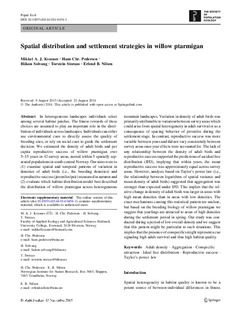| dc.contributor.author | Kvasnes, Mikkel A.J, | |
| dc.contributor.author | Pedersen, Hans Chr. | |
| dc.contributor.author | Solvang, Håkon | |
| dc.contributor.author | Storaas, Torstein | |
| dc.contributor.author | Nilsen, Erlend B. | |
| dc.date.accessioned | 2015-02-19T12:30:55Z | |
| dc.date.available | 2015-02-19T12:30:55Z | |
| dc.date.issued | 2014 | |
| dc.identifier.citation | Kvasnes, M. A. J., Pedersen, H.-C., Solvang, H., Storaas, T., & Nilsen, E. B. (2014). Spatial distribution and settlement strategies in willow ptarmigan. Population Ecology. doi: 10.1007/s10144-014-0454-1 | nb_NO |
| dc.identifier.uri | http://hdl.handle.net/11250/276768 | |
| dc.description.abstract | In heterogeneous landscapes individuals select among several habitat patches. The fitness rewards of these choices are assumed to play an important role in the distribution of individuals across landscapes. Individuals can either use environmental cues to directly assess the quality of breeding sites, or rely on social cues to guide the settlement decision. We estimated the density of adult birds and per capita reproductive success of willow ptarmigan over 5–15 years in 42 survey areas, nested within 5 spatially separated populations in south-central Norway. Our aims were to (1) examine spatial and temporal patterns of variation in densities of adult birds (i.e., the breeding densities) and reproductive success (juveniles/pair) measured in autumn and (2) evaluate which habitat distribution model best described the distribution of willow ptarmigan across heterogeneous mountain landscapes. Variation in density of adult birds was primarily attributable to variation between survey areas which could arise from spatial heterogeneity in adult survival or as a consequence of spacing behavior of juveniles during the settlement stage. In contrast, reproductive success was more variable between years and did not vary consistently between survey areas once year effects were accounted for. The lack of any relationship between the density of adult birds and reproductive success supported the predictions of an ideal free distribution (IFD), implying that within years, the mean reproductive success was approximately equal across survey areas. However, analysis based on Taylor’s power law (i.e., the relationship between logarithms of spatial variance and mean density of adult birds) suggested that aggregation was stronger than expected under IFD. This implies that the relative change in density of adult birds was larger in areas with high mean densities than in areas with low densities. The exact mechanisms causing this statistical pattern are unclear, but based on the breeding biology of willow ptarmigan we suggest that yearlings are attracted to areas of high densities during the settlement period in spring. Our study was conducted during a period of low overall density and we suggest that this pattern might be particular to such situations. This implies that the presence of conspecifics might represent a cue signaling high adult survival and thus high habitat quality | nb_NO |
| dc.language.iso | eng | nb_NO |
| dc.publisher | Springer | nb_NO |
| dc.title | Spatial distribution and settlement strategies in willow ptarmigan | nb_NO |
| dc.type | Journal article | nb_NO |
| dc.type | Peer reviewed | nb_NO |
| dc.source.journal | Population Ecology | nb_NO |
| dc.identifier.doi | 10.1007/s10144-014-0454-1 | |
